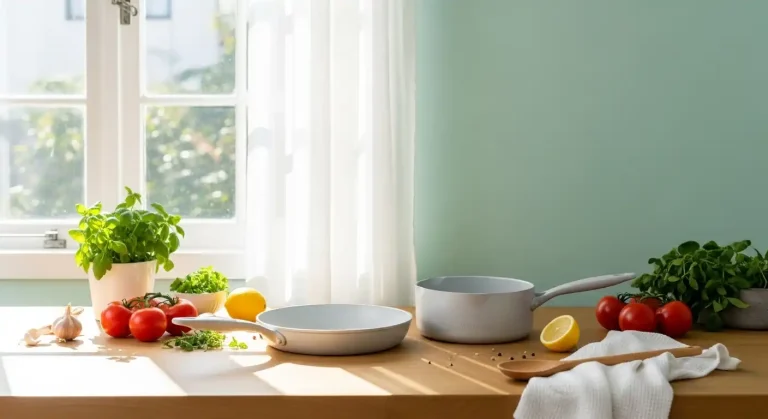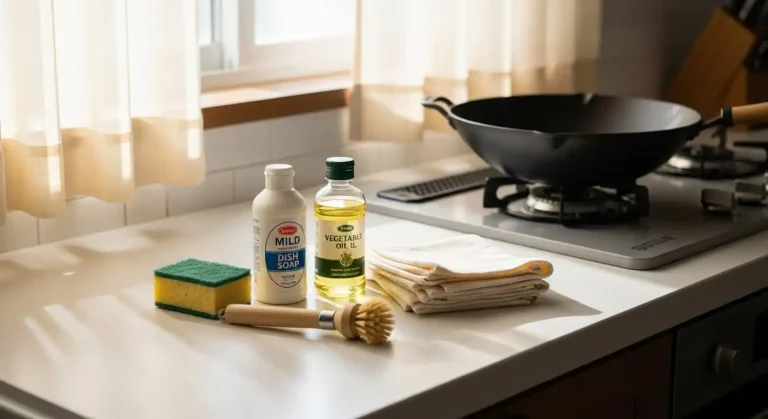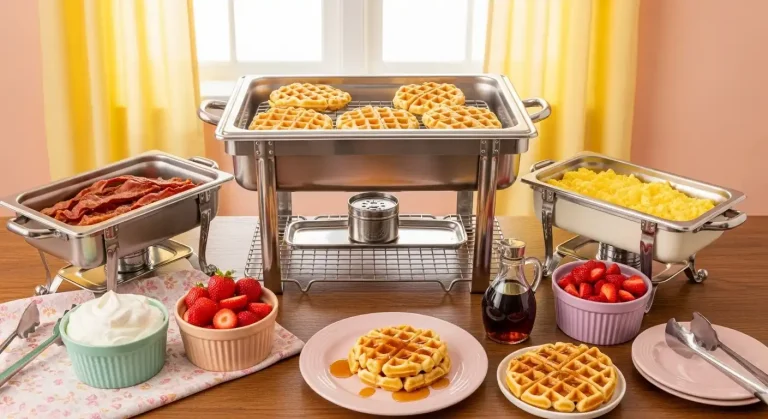Can A Stainless Steel Pan Go In The Oven Safely and Effectively Explained

Stainless steel pans are a popular choice in many kitchens due to their durability and versatility.
Many people wonder if these pans can safely be used in the oven, given the high heat involved in baking, roasting, or broiling.
The direct answer is yes: most stainless steel pans are oven safe, but the maximum safe temperature varies depending on the brand and construction, typically ranging from 400°F to 800°F.
It is important to check the manufacturer’s guidelines before placing a pan in the oven to avoid damage or safety issues.
🎄 Christmas & Year-End Amazon Deals !
Don’t miss out on the best discounts and top-rated products available right now!
*As an Amazon Associate, I earn from qualifying purchases.
Understanding the oven-safe limits and handling precautions can help users get the most out of their stainless steel cookware without compromising its integrity.
This knowledge allows cooks to use their pans confidently for a wide range of cooking methods.
Can A Stainless Steel Pan Go In The Oven?
Stainless steel pans are often designed to handle the heat of an oven, but usage depends on several key details.
Users must be aware of safety precautions, manufacturer instructions, and temperature limits to avoid damage or hazards.
Key Considerations for Oven Use
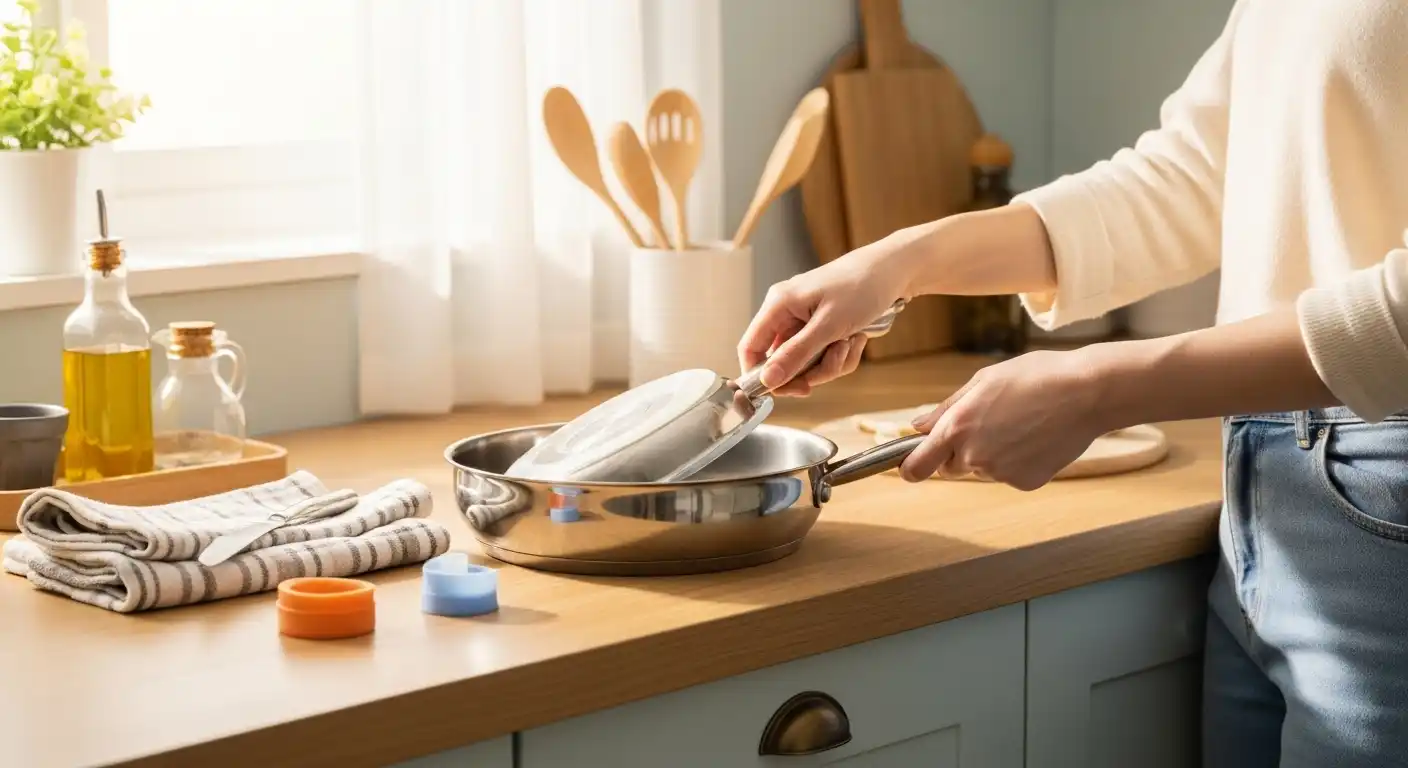
Stainless steel pans generally tolerate oven heat well, but the presence of non-metal parts like plastic handles or silicone grips can limit oven safety.
Heat conducts evenly through stainless steel, making it suitable for roasting or baking.
Users should always use oven mitts due to the pan becoming extremely hot.
Avoid sudden temperature changes, such as placing a hot pan into cold water, which can warp the metal.
Proper handling extends the pan’s life and maintains cooking performance.
Manufacturer Guidelines
Each stainless steel pan’s oven safety depends largely on the brand and model.
Manufacturers provide specific maximum temperature ratings, often ranging from 400°F to 800°F.
Following these guidelines prevents discoloration, warping, or damage.
Checking the owner’s manual or product details online is essential before placing the pan in the oven.
Some pans are explicitly labeled oven-safe, while others might not be recommended for oven use due to type of handle or coating.
🎄 Christmas & Year-End Amazon Deals !
Don’t miss out on the best discounts and top-rated products available right now!
*As an Amazon Associate, I earn from qualifying purchases.
Common Oven Temperature Limits
Most stainless steel cookware is safe between 400°F and 500°F.
Some premium lines allow temperatures up to 800°F, while budget options tend to have lower limits.
Temperature limits depend on construction details, especially handles and lids.
| Temperature Range | Typical Suitability |
|---|---|
| Up to 400°F | Standard stainless steel pans |
| 400°F – 500°F | Most mid-range cookware |
| 500°F – 800°F | High-end or professional models |
Users should stay within these ranges to ensure safety and longevity of the pan.
Exceeding the limits risks damage and voids warranties.
Identifying If Your Stainless Steel Pan Is Oven Safe
Determining whether a stainless steel pan is suitable for oven use requires careful inspection of specific features.
Important factors include the materials of the handle and lid, as well as the overall pan construction and any coatings.
These details affect the pan’s ability to withstand high temperatures safely.
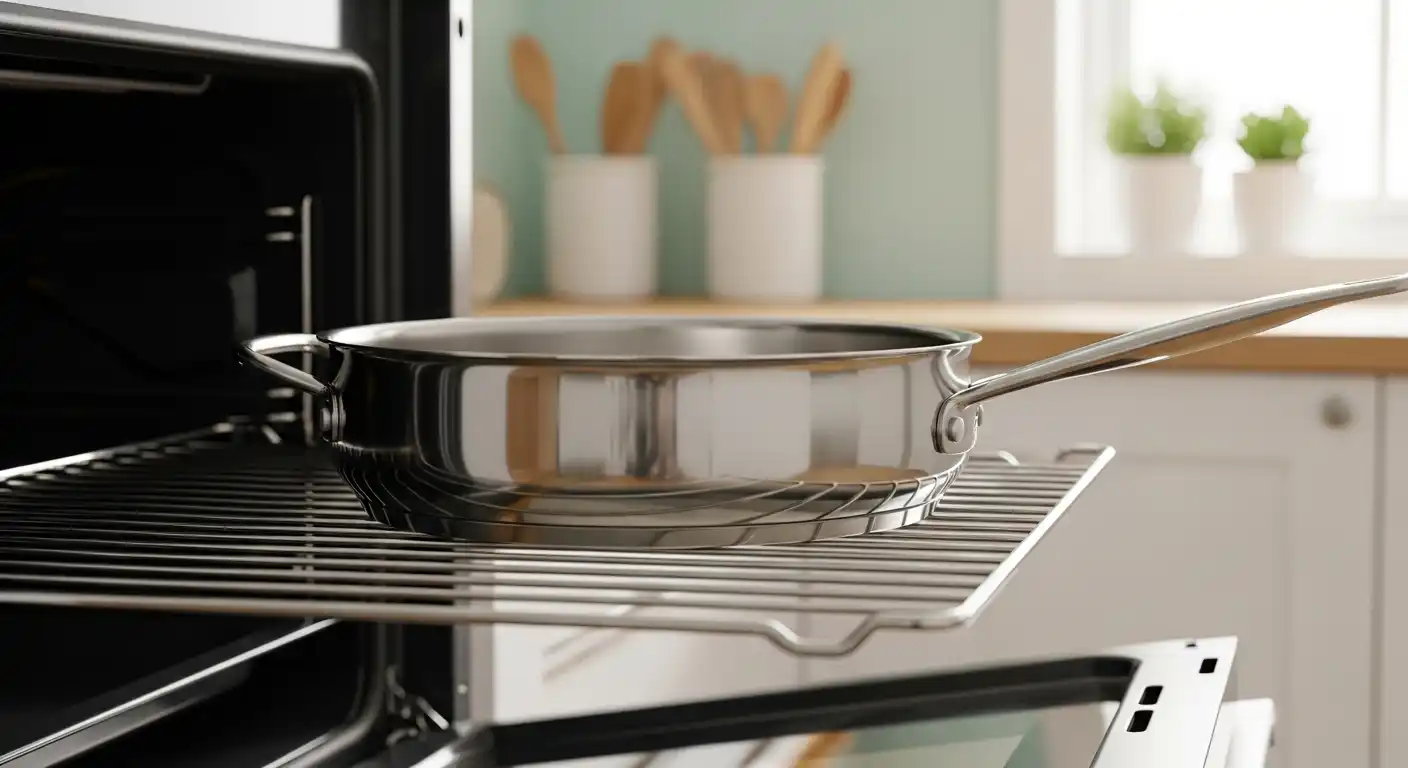
Checking Handle Material
Handles are a key consideration in oven safety. Stainless steel handles are typically oven-safe up to high temperatures, often between 400°F and 800°F.
However, handles made of plastic, rubber, or wood usually cannot tolerate oven heat and may melt or degrade.
Some pans feature silicone or detachable handles. Silicone handles may have temperature limits lower than stainless steel, often around 400°F.
It is essential to verify this limit from the manufacturer.
🎄 Christmas & Year-End Amazon Deals !
Don’t miss out on the best discounts and top-rated products available right now!
*As an Amazon Associate, I earn from qualifying purchases.
Screws or rivets securing the handle should also be metal. Non-metal fasteners can fail in an oven.
If the pan’s manufacturer guide is not available, testing handle material heat resistance is risky and not recommended.
Assessing Lids and Accessories
The oven safety of the lid is as important as the pan itself. Stainless steel lids are generally safe in the oven at the same temperatures as the pan body.
Glass lids often come with specified temperature limits, mostly between 350°F and 400°F, because they can crack or shatter under higher heat.
Handles on lids may have the same restrictions as pan handles.
Plastic or silicone knobs can limit oven use or require removal before placing the pan in the oven.
Some lids are designed to be oven-safe only if detached or removed.
If the pan includes accessories like steamer inserts or trivets, check their material and temperature limits separately before using them in the oven.
Reviewing Pan Construction
The stainless steel grade impacts the pan’s durability and oven safety.
Common grades for cookware, like 18/10, combine corrosion resistance with structural strength.
This makes them more reliable at high oven temperatures. The pan’s thickness and layering can affect heat tolerance.
Heavy-gauge pans distribute heat better and often withstand oven use more effectively than thinner models.
🎄 Christmas & Year-End Amazon Deals !
Don’t miss out on the best discounts and top-rated products available right now!
*As an Amazon Associate, I earn from qualifying purchases.
Coated pans require extra caution: nonstick layers typically have lower temperature limits, often under 500°F.
Any plastic or rubber components in the body or base reduce oven safety.
It is important to confirm that the pan has no such parts that may be damaged by heat before using it in the oven.
Manufacturer instructions are the most reliable source for these details.
How To Use A Stainless Steel Pan In The Oven

Using a stainless steel pan in the oven requires attention to temperature limits, safe handling, and appropriate cooking methods.
Proper preparation and careful placement help avoid damage to the pan and ensure even cooking.
Selecting suitable recipes can maximize the benefits of oven use with stainless steel cookware.
Preparation and Preheating Tips
Before placing a stainless steel pan in the oven, it is crucial to confirm its oven-safe rating, generally up to 500°F (260°C).
Avoid heating pans with plastic or wooden handles unless they are specifically rated for oven use.
Preheating the oven before introducing the pan ensures even heat distribution.
Do not place a cold pan directly into a preheated oven or a hot pan into a cold oven to reduce the risk of warping.
Applying a light coating of oil or butter helps prevent food from sticking and promotes even browning.
🎄 Christmas & Year-End Amazon Deals !
Don’t miss out on the best discounts and top-rated products available right now!
*As an Amazon Associate, I earn from qualifying purchases.
Avoid using non-stick sprays as they can build up residue on stainless steel.
Placing and Removing the Pan Safely
When placing the pan in the oven, use oven mitts or heat-resistant gloves to avoid burns.
Place the pan on a stable oven rack centered to promote even heat circulation.
Use caution when removing the pan, as stainless steel retains heat and remains hot after being taken out.
Set it on a heat-resistant surface and avoid direct contact with countertops that may crack from thermal shock.
Avoid rapid temperature changes, such as immersing a hot pan in cold water, to prevent warping or damage to the metal.
Recommended Recipes
Stainless steel pans excel at recipes requiring searing before oven finishing, such as pan-roasted chicken thighs or seared steaks.
The pan’s ability to transfer heat evenly makes it ideal for frying followed by roasting.
They also work well for dishes that need oven braising, such as short ribs or vegetable casseroles.
The pan should be heavy-bottomed and without plastic handles for best oven performance.
Avoid acidic recipes in pans with aluminum cores unless the manufacturer confirms compatibility, as acids can degrade the lining over time.
Potential Risks And Precautions
Using a stainless steel pan in the oven involves some risks that can affect the pan’s performance and safety.
Proper care helps prevent damage like warping, discoloration, burns, and other issues.
Knowing when and how to take action if problems arise is also essential.
🎄 Christmas & Year-End Amazon Deals !
Don’t miss out on the best discounts and top-rated products available right now!
*As an Amazon Associate, I earn from qualifying purchases.
Avoiding Warping and Discoloration
Stainless steel pans can warp if exposed to sudden temperature changes.
For example, moving a cold pan directly into a hot oven or taking a hot pan out and placing it on a cold surface can cause metal distortion.
To reduce this risk, it’s best to preheat the oven with the pan inside or allow the pan to warm gradually on a stovetop before transferring it.
Avoid very high temperatures above 500°F, especially with thinner pans, unless manufacturer guidelines confirm safety.
Discoloration often occurs from overheating or food residue burning onto the surface.
Cleaning the pan promptly after use and avoiding extreme heat helps maintain its appearance.
Preventing Burns and Injuries
Stainless steel handles may become very hot in the oven.
Users should always use oven mitts or heat-resistant gloves when handling pans after heating to prevent burns.
Some pans have plastic or rubber components not designed for oven use.
Confirm that all parts of the pan, including handles and lids, are oven-safe before placing it inside.
Using a small amount of oil or fat when cooking can reduce sticking, which minimizes the chance of hot food splattering and causing burns.
Responding to Unexpected Issues
If a pan warps during oven use, it may still be usable but can affect cooking performance, causing uneven heating.
🎄 Christmas & Year-End Amazon Deals !
Don’t miss out on the best discounts and top-rated products available right now!
*As an Amazon Associate, I earn from qualifying purchases.
Inspect it carefully for cracks or severe damage before further use.
If discoloration or burned residue appears, soaking the pan in warm soapy water and scrubbing gently can help restore it.
Avoid abrasive cleaners that can scratch the surface.
In case of accidental overheating or smoking, turn off the oven immediately and allow the pan to cool before handling.
Ventilate the kitchen if smoke builds up to ensure safety.
Alternatives To Using Stainless Steel Pans In The Oven
There are several cookware options that can be used instead of stainless steel pans when cooking in the oven.
These alternatives differ in heat retention, cooking properties, and ideal use cases depending on the recipe and cooking method.
Comparing With Other Oven-Safe Cookware
Cast iron, glass, and certain non-stick pans are popular oven-safe alternatives.
Cast iron excels in heat retention and even cooking but requires seasoning and careful maintenance to prevent rust.
Glass cookware offers excellent visibility of the cooking process and is non-reactive but doesn’t provide the same heat distribution as metal.
Non-stick pans specifically designed for oven use can simplify cleanup but often have lower temperature limits, generally around 400°F.
Checking manufacturer guidelines is important to avoid damage.
🎄 Christmas & Year-End Amazon Deals !
Don’t miss out on the best discounts and top-rated products available right now!
*As an Amazon Associate, I earn from qualifying purchases.
Overall, choice of cookware depends on heat tolerance, durability, and the type of dish being prepared.
| Cookware Type | Oven Safety Temp (approx.) | Key Advantage | Consideration |
|---|---|---|---|
| Cast Iron | Up to 700°F | Excellent heat retention | Requires seasoning and maintenance |
| Glass | Up to 450°F | Non-reactive, visible cooking | Less even heat distribution |
| Non-stick | Up to 400°F | Easy cleaning | Lower heat tolerance |
| Stainless Steel | Up to 500°F (average) | Durable, versatile | Check specific brand limits |
When To Choose Glass or Cast Iron
Glass cookware is best chosen for baking casseroles, roasting vegetables, or dishes where seeing the food cook is helpful.
It does not impart any flavor and is highly resistant to acidic ingredients. However, it heats more slowly and unevenly compared to metal pans.
Cast iron is ideal for roasting, frying, and recipes needing high, even heat like searing meats before finishing in the oven.
It is a versatile choice that can move from stovetop to oven without issue.
The downsides include weight and the need for proper care to maintain seasoning and prevent rusting.
Both glass and cast iron offer distinct advantages based on specific cooking needs and heat requirements.
Choosing between them depends on the recipe and desired cooking performance.
Cleaning And Maintaining Your Stainless Steel Pan After Oven Use
Proper care after oven use preserves the pan’s finish and performance.
Attention to temperature, cleaning agents, and scrubbing tools is crucial to prevent damage and maintain its appearance.
Proper Cleaning Techniques
The pan should cool completely before cleaning to avoid warping. Use warm water and mild dish soap to remove surface food residue.
A non-abrasive sponge or soft cloth is recommended to protect the finish.
Avoid harsh cleaners like bleach or oven cleaner, as well as abrasive materials such as steel wool or scouring pads.
These can cause permanent surface damage, including scratches and discoloration.
For baked-on food, soaking the pan in warm, soapy water helps loosen residue. After soaking, gentle scrubbing with a soft sponge is enough for most stains.
Dealing With Stains or Residue
Discoloration from high heat or burnt food deposits is common after oven use.
Applying a mixture of vinegar and water can help restore shine and remove mild stains. It should be used sparingly and wiped off immediately.
Stubborn burnt-on residue may require specialized stainless steel cookware cleaners designed to break down tough deposits without harming the surface.
Regular maintenance, including wiping the pan dry after washing, prevents water spots and rust formation.
Proper drying and storage also protect the pan from moisture-related damage.

